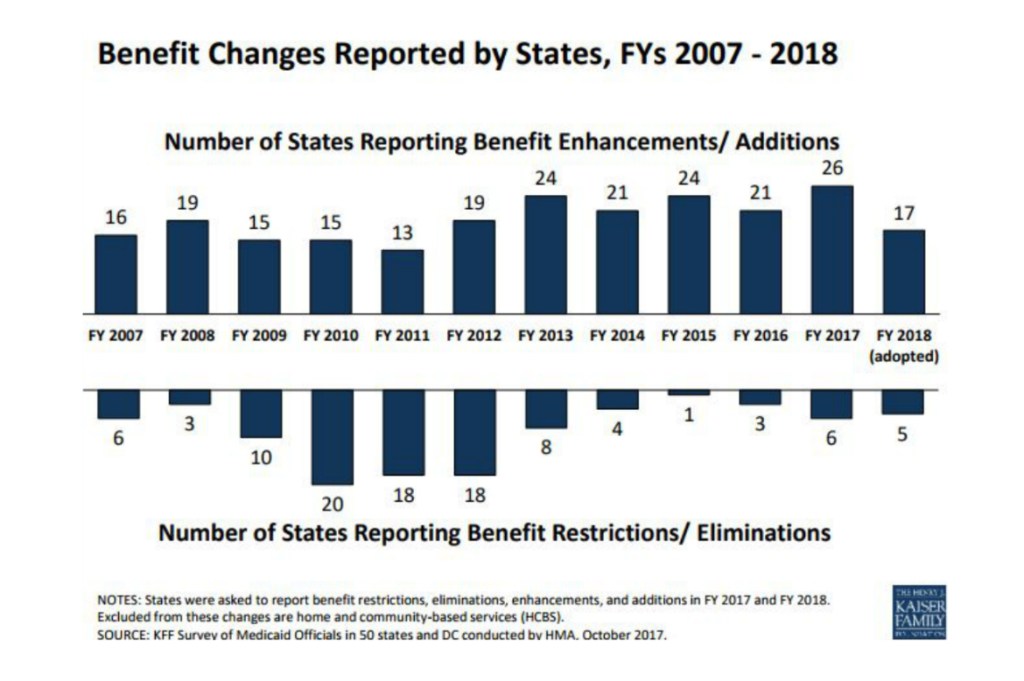While congressional Republicans and President Donald Trump have been seeking major cuts in federal funding of Medicaid, 26 states this year — including California –expanded or enhanced benefits and at least 17 plan to do so next year, according to a report released Thursday.
The increased benefits were largely for mental health and substance abuse treatment, but states also added telemedicine and dental care, according to the report by the Kaiser Family Foundation and the National Association of Medicaid Directors. (Kaiser Health News is an editorially independent program of the foundation.)
The number of states adding benefits was the highest in at least a decade, according to the 50-state survey. Last year, 21 states expanded benefits.
Just six states moved to cut Medicaid benefits in fiscal 2016.
Oregon last year became the first state to provide coverage for oral contraceptives prescribed by a pharmacist, rather than a doctor, with its Medicaid program, the report said.
Four states — Louisiana, Virginia, South Dakota and New York — added cancer screening benefits such as paying for genetic testing for the BRCA breast cancer gene mutation.
As for California, it restored acupuncture services in the 2016-2017 fiscal year that previously had been eliminated for most patients and added licensed midwives to a statewide program serving pregnant Medicaid patients to boost access to care. In 2017-2018, California will restore some previously eliminated benefits for dental care to the program, known here as Medi-Cal, according to the survey.
In earlier years, California enhanced its Medicaid program by adding telehealth services, making substance abuse treatment more available and requiring more accountability from the managed care organizations that serve nearly 80 percent of the state’s Medi-Cal recipients, according to the survey.
The state is pitching in $1.3 billion this year for its contribution to the federal-state health program, straining its overall budget.
Yet the state’s reimbursement rates for health providers remain among the lowest in the country and access to care remains a concern for some patients.
Medicaid, the state-federal health insurance program for the poor, covers nearly 75 million people and is one of the largest programs in state budgets. States generally add benefits to Medicaid during strong economic times. About a third of California adults and half of the state’s children are covered by Medi-Cal.
States added the benefits while Congress debated making significant changes to the program, including ending the open-ended federal spending that has been a staple of the program since its beginning in 1966. The Republican efforts, including bills to replace the Affordable Care Act, have withered after stiff opposition from advocates and Democrats and three moderate Republicans in the Senate.
Medicaid also faces uncertainty as the Trump administration weighs whether to allow states for the first time to require non-disabled, adult enrollees to work in order to qualify for benefits. At least six states have such a request pending with the Centers for Medicare & Medicaid Services, and a decision is expected before end of the year.
California took early and aggressive action to expand Medi-Cal to cover an additional 3.6 million residents by 2016. The state also extended full Medi-Cal benefits to children living in the country illegally but has stopped short of offering them to young adults.
Robin Rudowitz, associate director for the Kaiser Family Foundation’s Program on Medicaid and the Uninsured, said states now are adding benefits to respond to the national opioid abuse problem. States are also continuing the trend of giving enrollees who are elderly or have serious health problems the ability to remain in their homes longer instead of going to nursing homes. She said more states have been expanding benefits for several years coming out of the Great Recession, which ended in 2009.
“We are seeing the delayed effects of the improving economy — enrollment growth is going down … and states are increasing provider [reimbursement] rates and restoring and adding benefits,” she said.
Even while Maine, Indiana, Kentucky and other states want to add an adult work requirement to Medicaid, which will make it harder for some people to qualify, some of these same states and others are enhancing benefits, she said.
“All of this is happening against a backdrop of major uncertainty about what is going to happen at the federal level,” Rudowitz said.
After three years of supersized enrollment growth that peaked in 2015 as a result of most states expanding coverage under the ACA, Medicaid enrollment growth slowed to 2.7 percent nationally in fiscal year 2017, which ended Sept. 30, down from 3.9 percent the year before, according to a second Kaiser report also released Thursday.
Overall Medicaid spending increased 3.9 percent in 2017, up from 3.5 percent in 2016. States reported that increase reflected higher spending on such things as prescription drugs and long-term care services.
The states’ share of Medicaid spending grew by 3.5 percent also in 2017 but is expected to go up 6 percent in 2018. That increase is mostly a result of states starting to pay 5 percent of the cost of new enrollees covered under the ACA expansion. The federal government paid the full costs for those enrollees through 2016.
The survey was conducted by analysts at the Kaiser Family Foundation and Health Management Associates.
California Healthline senior correspondent Barbara Feder Ostrov contributed to this report.
CORRECTION: This story was updated on Oct. 19 to correct an editing error. The survey was conducted by analysts from both the Kaiser Family Foundation and Health Management Associates, not just Health Management Associates.
This story was produced by Kaiser Health News, an editorially independent program of the Kaiser Family Foundation.


